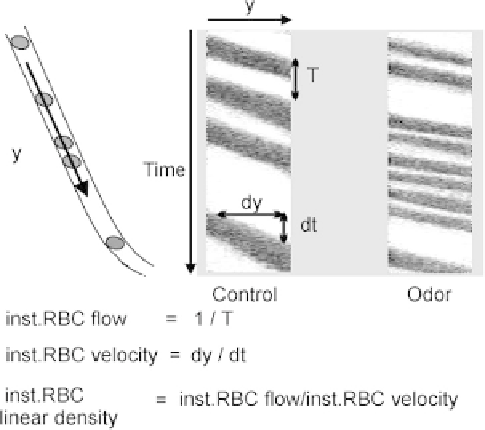Biomedical Engineering Reference
In-Depth Information
Fig. 4.2. Longitudinal line scans through a capillary reveals red blood cells (RBCs) as
oblique shadows. RBC velocity (dy/dt) increases during odor (right).
responses, vascular responses are concentration-dependent and
odor-specific. In our initial study
(56)
, we measured blood flow
in contiguous glomeruli and observed that vascular responses
seemed glomerular-specific. However, because optical functional
imaging of calcium
(28, 29)
, voltage
(31)
and intrinsic signals
(32-37)
have demonstrated that several clustered glomeruli are
often activated by an odor and because we did not map responses
in all contiguous glomeruli, it remained unclear whether vascular
responses are regulated at the level of a single glomerulus.
6. Vascular
Responses Involve
Several Clustered
Glomeruli in Most
Cases
Solving the problem (of clustered activation of glomeruli)
requires to find the ideal condition where only one glomeru-
lus is activated. However, this condition is impossible to ascer-
tain using either TPLSM imaging of blood flow at the level of
a single capillary or other optical imaging techniques. The first
approach is so precise that it would require to screen one capillary
per glomerulus over a large portion of the dorsal olfatory bulb.
Other optical techniques detect signals generated by the activa-
tion of neuronal populations even though activation of a few cells
may be sufficient to trigger vascular responses. We thus recently
used an alternative approach which relies on the pharmacological
inactivation of synaptic transmission or even of neuronal activ-
ity of all the neurons belonging to a single glomerular module
(60)
. To our surprise, such glomerular inactivation (with pressure

